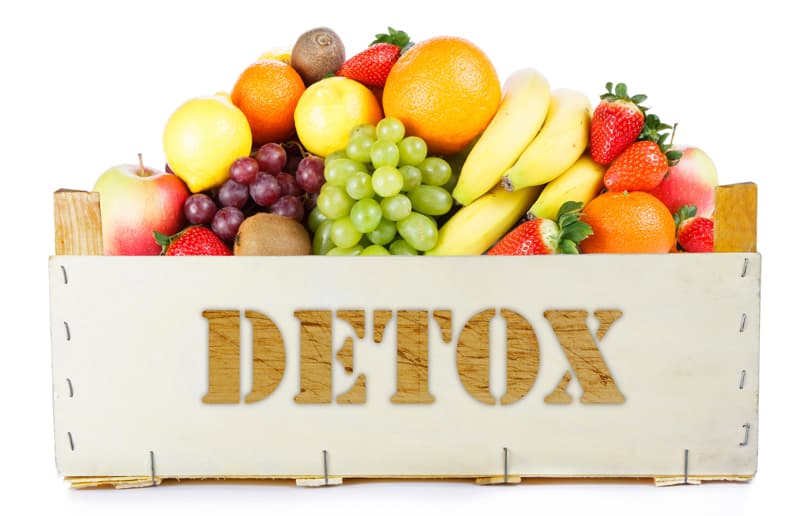
In this newsletter:
- The Importance Of A Body Detox
- Products Of The Month
- Colds, Influenza And Your Immune System
- The Different Forms Of Vitamin C
- Broccoli Orange Salad
THE IMPORTANCE OF A BODY DETOX

The notion that diet and detox programs go hand-in-hand is a misconception. While some individuals do tend to lose weight on a detox, others might gain weight. A detox program should not be confused with a diet. So what is a detox exactly? Detox is simply a change in diet to lighten the load on the vital organs in the body in order to gain greater health.
The Body’s Detoxification System
In total, the body has six channels for detoxification: the lympathic system, the colon, the kidneys, the lungs, the sinuses and the skin, which is responsible for the backup removal of acid and other wastes if the above-mentioned channels are overloaded.
Potential Dangers And Diseases Without A Body Detox
Toxins enter the body through foods, drinking water, exposures to the environment, points of contact and stress, which inhibits the body’s ability to absorb nutrients, rest and repair itself.
Without a detox, the frontline – or defense – of the intestines is broken due to the large quantities of toxins present in the body. With time, the toxins will start to leak out of the intestinal walls and into the blood stream. As a result, diseases such as bowel toxaemia (blood poisoning) or candidiasis (infections caused by fungi) could potentially occur.
Why Detox In Spring?
During the winter, the levels of toxins that has entered the body will most likely be higher than at other times of the year, due to the specific foods eaten, the amount of food, the toxic points of contact made and the lack of exercise to keep the digestive system active. Spring and Fall times are ideal for liver detoxification.
PRODUCTS OF THE MONTH - 5% OFF

Our product of the month is C1000 - the purest form of vitamin C. It is significant that you get your daily dose of vitamin C, as it is not stored in the body. Vitamin C is required in order to maintain strong bones, joints and skin.
We are also continuing with the D Mulsion 1000 IU as our product of the month. Due to the lack of sunshine these days there is a minimal natural intake of vitamin D in the body.
COLDS, INFLUENZA AND YOUR IMMUNE SYSTEM

It is that time of the year again – the sniffles, the colds and the flues are back. The flu and related viruses spread through tiny droplets of fluid containing the virus and are passed on through sneezing, coughing or touching – either directly or indirectly via items. Depending on where the droplets fall, the virus can live from a few minutes to 48 hours, making it plausible for several individuals to get infected.
So what is the reason behind the “flu season” and how does the immune system play a significant role during these winter months? In winter, the body is weaker due to stress, which highly affects the white blood cells, the body’s defense against viruses. The body’s immune system is build to withstand and avoid illnesses and viruses, as it is a balanced network of cells and organs that work together to fend off diseases. This system is highly affected if the body is constantly fighting negative health habits, such as poor diets, little sleep and too much stress – many of which are present during the winter months and Christmas holidays.
Furthermore, the flu virus survives for longer periods indoors during the winter months because the relative humidity of indoor air is very low when compared to the outside air. And since humans tend to be inside more often during the winter months, the contact between people is more frequent, making it easy to become infected.
The flu virus may also stay suspended in the air for a prolonged period of time and thus, infect others when air is inhaled. The virus droplets can essentially infect the body if they land on sensitive areas, such as the eyes, nose or mouth.
Call us at (416) 913 4325 to schedule your naturopathic appointment and to learn about our healthy lifestyle programs to help you be symptom free this flu season with natural and effective remedies.
THE DIFFERENT FORMS OF VITAMIN C

Vitamin C is an essential nutrient for human beings, as it is required for metabolic reactions in humans, animals and even plants. It is a powerful anti-oxidant in the body, but despite its power and strength, vitamin C is quickly lost from the body. Thus, daily intake of this particular vitamin is crucial.
Vitamin C is involved in a large number of biological processes in the body, including creating collagen (a protein that makes bones, skin and joints stronger), healing wounds within the body and essential for the body’s immune system by maintaining activity for the white blood cells.
Being vitamin C deficient can lead to dry / splitting hairs, gingivitis, bleeding gums, rough and dry ski, decreased wound healing, easy bruising, nosebleeds, weakened tooth enamel, swollen and painful joints, anemia, decreased efforts in fighting infections, and possible weight gain due to slowed down metabolism. A lack of vitamin C can also lead to scurvy, a condition where the collagen becomes too unstable to perform its function.
Ascorbic acid is often associated with vitamin C. However, ascorbic acid is not a natural source of the vitamin. Rather, it is a white or light yellow crystal powder, which is added to many foods for its nutrients but also to preserve foods to prevent flavours and colours from being damaged by oxidation. Ascorbic acid does have its side effects, including hardening of the arteries, potential to damage generic materials (DNA) and ascorbic acid has been shown to increase the process of cancerous umours and provide a thriving environment for cancer cells.
Natural vitamin C is found in foods, particularly fruits and vegetables. A sufficient amount of vitamin C are found in oranges, lemons, limes, grapefruits, tangerines, pears, bananas, melons, papayas, strawberries, mangoes, blackberries, blueberries, kiwis, pineapples, watermelons, raspberries, cranberries, cantaloupes, rose hips, acerola cherries, asparagus, broccoli, green peppers, cabbage, kale, cauliflower, potatoes, turnip greens, onions, corn, pumpkin, carrots, parsley, sauerkraut, and garlic.
SBROCCOLI ORANGE SALAD RECIPE

The focus of this newsletter is on the importance of vitamin C and D, particularly during the winter months and flu seasons. To help you on the right track in terms of getting the sufficient amount of both vitamins, the recipe this month has both!
Ingredients:
The dressing is optional! The primary sources of vitamins in this salad are found in the vegetables. However, some prefer a little extra to spice up their salads. This dressing does require a marinating period of several hours, but it is low in fat and promises a kick!
Dressing:
- 2 eggs
- 1/2 cup of fat free sour cream
- 1/4 cup white wine vinegar (optional)
- 1 pinch of garlic
- 1/4 cup of water
- 1 1/2 teaspoon of dry mustard
Salad:
- 4 cups of fresh broccoli florets, well drained
- 2 1/2 cups sliced fresh mushrooms
- 1/3 – 1/2 cup sliced toasted almonds (or to taste)
- 1 cup of raisins
- 1 large orange, peeled
- 1 small red onion, sliced or diced
Instructions:
- In a saucepan, mix or whisk the eggs and the dry mustard.
- Whisk in water (and vinegar) and cook on low heat until thickened.
- Remove from heat. Stir sour cream and garlic into the mix. Let it cool.
- Marinate broccoli for 3-4 hours in the dressing.
For any questions, or concerns, or to schedule an initial naturopathic appointment, please contact us at 416 913 4325 (HEAL) or email us at [email protected]
* DISCLAIMER: The information on this article is the property of Dr. Sushma Shah, Naturopathic Doctor, and is not intended to treat, diagnose or cure any diseases or promote any services or products mentioned on the website.
Related Articles
Acne
Acne is a common skin condition with a prevalence of 80% in female and 90% in male teenagers. It is caused by a disorder of the oil glands that result in clogged pores and outbreaks of lesions commonly known as pimples. Risk factors: poor diet, excessive sugar, trans fats and processed foods.
Candidiasis
Candida overgrowth in the gastrointestinal tract is now becoming recognized as a complex medical syndrome known as chronic candidiasis or the yeast syndrome. Symptoms include: Multiple food allergies, or allergic to all foods( pan allergic), alternating diarrhea with constipation.
Chronic Fatigue
Chronic Fatigue Syndrome (CFS) is described as a severe, debilitating fatigue, lasting at least six months (of new and definite onset), associated with at least four of the following symptoms: impaired memory or concentration, sore throat, muscle pains, joint pains, unrefreshing sleep and post-exertion malaise.
Irritable Bowel Syndrome
Irritable bowel syndrome (IBS) - a diagnosis of exclusion, this condition is often misdiagnosed. Severe food intolerances / allergies may exhibit symptoms that are similar to Irritable Bowel Syndrome such as pain, cramping, gassiness, sudden bouts of diarrhoea, and constipation.
